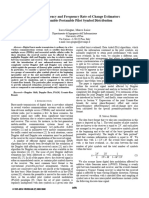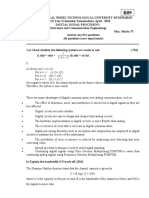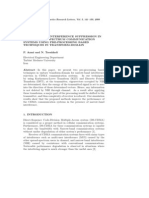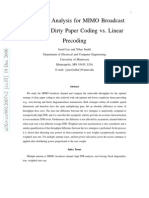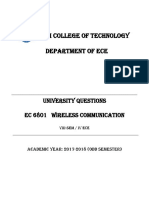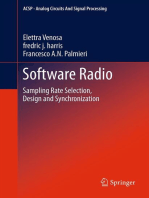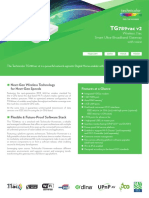Doppler Spread Estimation in Mobile Communication Systems: Young-Chai Gibong Jeong
Doppler Spread Estimation in Mobile Communication Systems: Young-Chai Gibong Jeong
Uploaded by
82416149Copyright:
Available Formats
Doppler Spread Estimation in Mobile Communication Systems: Young-Chai Gibong Jeong
Doppler Spread Estimation in Mobile Communication Systems: Young-Chai Gibong Jeong
Uploaded by
82416149Original Title
Copyright
Available Formats
Share this document
Did you find this document useful?
Is this content inappropriate?
Copyright:
Available Formats
Doppler Spread Estimation in Mobile Communication Systems: Young-Chai Gibong Jeong
Doppler Spread Estimation in Mobile Communication Systems: Young-Chai Gibong Jeong
Uploaded by
82416149Copyright:
Available Formats
DOPPLER SPREAD ESTIMATION IN MOBILE COMMUNICATION SYSTEMS
Young-Chai KO Gibong Jeong
Wireless Center Wireless Center
Texas Instruments Inc. Texas Instruments Inc.
San Diego, CA 92121, USA. San Diego, CA 92121, USA.
Email: <ykoQti .com> Email: <gjeong@ti. com>
ABSTRACT Numerous techniques have been proposed .and used
to estimate the Doppler spread and velocity. Most
A new technique based on the auto-correlation function
of the prior techniques can be categorized into two
is described for the estimation of the Doppler spread
classes: the techniques based on the level crossing rate
in mobile communication systems. We first propose to
(LCR) [l, 51 and the ones based on the covariance of
divide a uncertainty region of Doppler spread into mul-
the channel estimates [5, 61. The performance of the
tiple frequency bins. Based on the given multiple bins
estimators based on these two schemes has been ex-
the correlator compares the estimated value at a cer-
tensively studied and shown in 14, 5, 6, 71. All of the
tain time index to the theoretical exact value and then
above techniques have proven to be efficient and also ro-
decides which bin the Doppler spread is estimated in.
bust to various of the propagation environment. How-
The certain time index can be optimized to give the
ever, both methods require a high signal-tenoise ratio
largest decision region among multiple bins. We derive
(SNR) for reliable estimation that is not adequate for
the optimum time index algorithm to give the largest
mobile communication system.
decision region for each bin based on Rayleigh fading
channel. We also apply the same Doppler spread esti- In this paper, we propose a new Doppler spread es-
mator to the Rician case with the slight transformation timator, named as correlation based approach which
of the received signal. We show that the proposed tech- is robust to additive white Gaussian noise (AWGN),
nique is not affected significantly by the Rician factor i.e., works well for low SNR, regardless of the variation
and the SNR degradation with the reasonable number of channel environment. First, we propose to divide a
of samples for estimation which is not the case of other uncertainty region of Doppler spread into multiple fre-
estimators given in the literature. quency bins. This is motivated by the fact that most
receiver algorithms do not need high accuracy of the
Doppler spread estimation but requires knowledge if a
1. INTRODUCTION
mobile is in fast (F-mode), medium (M-mode) or slow
The signal received by a mobile receiver varies over mode (S-mode). In Table 1 three bin division is shown
time and space because of interference between one or where we restrict the maximum value of the Doppler
more versions of transmitted signal which arrive at the spread for a practical consideration to 500 Hz corre-
receiver at slightly different times. These waves, called sponding to the vehicle speed u = 270 Km/Hr for the
multipath, combine at the receiver antenna and vary in carrier frequency f,=2 GHz and assume that there is
amplitude and phase over time. The Doppler spread, no case faster than this maximum value. Based on
fd, which is related to the wavelength of the transmit-
three bin division as shown in Table 1, our proposed
ted signal, A, and the vehicle speed, v, as fd = v/A [l], Doppler spread estimator compares the estimated cor-
determines how fast the signal varies or fades. Since relation value with the theoretical value of the correla-
the performance of many receiver techniques depends. tion function at the optimum delay time which maxi-
on the fading rate of the received signal, an adaptive mizes the decision region among the F-mode, M-mode
communication receiver can improve the performance and S-mode.
and reduce the complexity by using the Doppler infor- The remainder of this paper is organized as follows.
mation to control receiver parameters, such as pilot fil- Section I1 presents the signal model under considera-
ter bandwidth, automatic gain control loop bandwidth, tion. In Section 111, the new Doppler spread estimator
phase tracker bandwidth and interleaver size [2]. The is derived over the Rayleigh and Rician fading chan-
Doppler information is also used to aid hand-off process nels. Finally, the numerical results and the conclusions
in cellular communication systems [3, 41. are summarized in Section IV.
0-7803-7484-3/02/$17.00 02002 IEEE. VTC 2002
1941
Table 1: Three bin division for Doppler spread estimation.
Figure 1: Implementation of correlator in which the
auto-correlationvalue at a certain time index nj is nor-
malized to the energy of the signal, where N denotes
2. SIGNAL AND NOISE MODELS the number of samples to be used for the estimation of
Doppler spread.
We assume that the received complex baseband signal,
r ( t ) , at the discrete time t = kT,, corrupted by AWGN
has the following form the &function in (4) is replaced to sinc (= sin(z)/z)
r(k) = z(k)+n(k) = (z(k)+ni(k))+j(y(t)+n,(t)) (1)
function with a certain noise bandwidth. Note from (4)
that the additive noise does not take effect on the shape
where the received signal z ( k ) is the resulting super- of the auto-correlation function except at T = 0. We
position of all multipath components at the output denote the time delay T in discrete version as T = njTs
of the receiver antenna, z(k) and y(k) are in-phase with sampling time T,and an integer nj.
and quadrature components of z ( k ) , In (l), n ( k ) = Now we want to estimate the Doppler spread as
ni(k)+jn,(k),is complex AWGN with two-sided power one of three bins, S-mode, M-mode and F-mode as in
spectral density, E[n?(k)]= E[ni(k)]= N0/2, where Table 1 by seeing the correlation value at a certain
E[.] is the average operation. Denoting E [ z 2 ( k ) ]= time indexes nj. Let us denote n1 as the time index
E[y2(k)]= E[z2(k)]/2 = Q/2 the average SNR of the which decides if the Doppler spread is in M/Smode or
received signal can be written as F-mode. This value of n1 can be chosen to be integer
value satisfying the following condition
. T,) = Max[Jo(t)]+Min[Jo(t)1
J o ( 2 ~250.7~1
.
= -= 0.2986 for real 2
value t , (5)
3. DOPPLER SPREAD ESTIMATION
where we set the sampling frequency T,=1/15000see
3.1. Rayleigh Fading Channels ond, and it is found to be given by nl=l8. Note
The Rayleigh distribution is frequently used to model in (5) that the correlation function is monotonically
multipath fading with no direct lineof-sight (LOS) path. decreasing over fd E [0,500] Hz and has the middle
In this case the z(t)and y ( t ) in (1) are zero-mean Gaus- point of the maximum and minimum value of Jo(t)
sian with variance a2 = 012 and the auto-correlation for real value t at nl=18 by which the false proba-
function has the form [l] bility of the S(F)-mode can be minimized and the deci-
sion region between M-mode and F-mode can be max-
fl imized. Given nl=l8, the theoretical correlation value
CZZ(~) +
= E [ z ( k ) Z ( k T ) ] = yJO(2"fdT) for fd = 250 Hz, is calculated from (3) as Jo(2x .250.
).( = '22 (') 7 (3) 18. T,)= 0.2906. Letting the threshold Ti1') = 0.2906
the Doppler spread can be estimated as the MIS mode
where .lo(.) is the Bessel function of the fist kind. Con- if the correlator p(n1) is larger than Til8), otherwise
sidering the noise component in (l), the auto-correlation it is estimated as F-mode, where the correlator p ( n j )
of the in-phase component can be shown, assuming that can be implemented as shown in Fig. 1. We note from
ni(lc)and n,(k) are independent of z ( k ) and y(k), to Fig. 1 that the p ( n j ) is the normalized function of the
be given by autecovariance function to the average signal power in
(4) and hence the maximum value of p ( n j ) is set to 1.
Once M/Smode or F-mode is decided, the next step
is to decide if the Doppler spread is in Smode or M-
(4) mode. Using the same value as a time index nl = 18 we
+ +
where ri(k) = z ( k ) ni(k),r,(k) = y(k) n,(k), and have the threshold Ti1') = Jo(27r 60.18. T,)= 0.9495.
6(.) is the impulse function. For bandlimited noise, Based on the thresholds Til8) and Ti") the Doppler
0-7803-7484-3/02/$17.00 02002 IEEE. VTC 200:!
1942
spread can be estimated as the rule of
If p(nl = 18) > Tr8), declareM/S - mode
TP),
[ If p(n1 = 18) >
Else declare M-Mode
Else declare F-Mode.
declares - mode
In (6) the estimation region between S-mode and M-
(6)
mode is relatively very small to the one between S/M-
mode and F-mode which might result in the false alarm Figure 2: Application of Doppler spread estimator de-
probability of the S(M)-mode to be estimated as M(S)- rived from Rayleigh fading channel to Rician fading
mode to be higher than the probability of the M(F)- environment.
mode to be estimated F(M)-mode. Adopting another
time index 122 which can be chosen in a similar manner
as nl in (5)t o satisfy spread estimation algorithm described in Rayleigh fad-
ing case cannot be applied due to the different shape of
the auto-correlationfunction between (3) and (9). Be-
sides the effect of AOA we now seek a way to avoid the
effect of Rician factor K on the estimation of Doppler
we have 122 = 50. Using two thresholds we decrease spread using the same algorithm in (8) as Rayleigh fad-
the false alarm probability to estimated the S-mode as ing case. For this purpose we make the received signal
M-mode. Denoting the threshold Tis0) = Jo(2n.60.50. DC free, Le., E[z(t)]= E[y(t)]= 0 by eliminating
T,)= 0.6453, the algorithm in (6)for the estimation of the mean value of the in-phase or quadrature compo-
the Doppler spread can be modified as nent. The schematic diagram is shown in Fig. 2 in
which the estimator employs the DC removal block,
If p(n1 = 18) > T Y ) , declareM/S - mode
i
transforms the Rician fading received signal to the sig-
If p(n2 = 50) > T Y ) , declares - mode nal having the property the same as Rayleigh fading
Else declareM - Mode signal, and apply the same algorithm to estimate the
Else declareF - Mode. Doppler spread. Eliminating the specular component
by making the signal DC free causes the SNR given in
(8)
We clearly see from Fig. 3 that using two thresholds (2) to decrease and might result in the degradation of
can give more decision region between S-mode and M- the performance of Doppler spread. However it is no-
mode. table that if SNR degradation is not from the increase
of the noise variance but from the reduction of the sig-
nal itself, the correlator which is normalized version of
3.2. Rician fading channel
the auto-correlationfunction operates regardless of the
For a multipath fading channel containing a LOS com- SNR change.
ponent, z(t) and y ( t ) in (1) have non-zero mean. De-
noting s as the LOS component and the variance of z(t) 4. SIMULATION RESULTS
and g ( t ) as 02, the autcxovariance function is given
by PI In this section some simulation results using the pro-
posed Doppler spread estimator are illustrated. As a
1 R
c z z ( T ) = --
K+12
JO(2TfdT) + C O S ( ~ Tfd7cosOoperformance measurement, we define the conditional
probability given the Doppler spread as the probability
K O (970 be estimated as S, M or F-mode given the Doppler
CZY(T)= -- ~ cos eo),
s i n ( 2fd
K+12 spread fd, P[S or M or FI fd]. The assumption for this
are made as followiWZ:
where the Rician factor, K, is defined as the ratio of
the power in the LOS component and scattered com-
ponent, i.e., K = s2/(202),
sampling frequency fs = kZl5KHz,
. . . 80 is the angle of arrival
(AOA) of the LOS component, and the average power 2. carrier frequency fc=2 GHz,
+
is O = s2 202. The auto-correlation function of the
received signal in (9) is in more complicated form in- 3. isotropic scattering, i.e, there is no AOA effect on
volved with AOA and K. In this case the Doppler ' the Doppler spread estimation,
0-7803-7484-3/02/$17.00 02002 IEEE VTC 2002
1943
4. Rayleigh and Rician fading channel is generated
based on the technique presented in [8],
5. Doppler spread does not exceed 500 Hz.
4.1. Effect of AWGN
Figs. 4-5 show and compare the performance of the
Doppler spread estimator using a single correlator in
(6) and two correlators in (8) with SNR y=10 dB and Figure 3: Auto-correlation function at the time indexes
20 dB, respectively. We can clearly see from these re- n = 18 and = 50. The threshold T$l5)=O.2906 is set
sults that the performance of Doppler estimator using for the decision between MIS-mode and F-mode and
two correlators outperforms the case of a single corre-
T2(l5)=O.9495 and Ti1’) =0.6453 are used for the de-
lator particularly in the low value of Doppler spread, as
cision between S-mode and M-mode, for the Doppler
expected. Using the LCR of the envelope and covari-
estimator with a single correlator and two correlators,
ance based Doppler estimators presented in [l]the ad-
respectively.
ditional simulation results not illustrated in this paper
show that P[SI fd]=O, P[SI fd]=O, and P[SI fd]=l over
most range of Doppler spread for the SNR below 20 most of Doppler spread region except the boundary of
dB. We also find that there is no much degradation of the bin transition.
the performance due to the decrease of SNR. Note also
that the correct probability to detect the small value
of the Doppler spread is a bit lower than the case of REFERENCES
high speed. It can be interpreted from (4) that AWGN
[l] G. L. Stiiber, Principles of Mobile Communications.
takes the effect on the correlation function near time
Boston, MA: Kluwer Academic Publishers, 1996.
offset value at 7 = 0 for a k e d Doppler spread or the
small value of the Doppler spread for a fixed time offset [2] A. Chockalingam, P. Dietrich, L. B. Milstein, and R. R.
value. Rao, “Performanceof closed-loop power control in DS-
CDMA cellular systems,” IEEE Trans. Veh. Technol.,
V O ~ .47-3, pp. 774-789, August 1998.
4.2. Effect of Rician Factor K [3] M. D. Austin and G . L. Stuber, “Velocity adaptive
Figs. 6-7 present the effect of two different value of handoff algorithm for microcelluax systems,” IEEE
Pans. Veh. Technol., vol. 43, pp. 781-785, March 1994.
Rician factor K = l and K=10, using a single and two
correlator for y=20 dB. Changing the Rician random [4] J. M. Holtzman and A. Sampath, “Adaptive averag-
variables (RVs) to Rayleigh RVs by eliminating the ing methodology for handoffs in cellular systems,” IEEE
specular component as shown in Fig. 2 the proposed ’prans. Veh. Technol., vol. VT-44, pp. 59-66, February
1995.
estimator can indeed avoid the effect of Rician factor
K. In this simulation the noise variance remains the [5] C. Tipedelenlioglu, A. Abdi, G. B. Giannakis, and
same but the signal variance changes for SNR ,y,to be M. Kaveh, “Estimation of Doppler spread and signal
k e d at 20 dB As mentioned in 3.2, there is no per- strength in mobile communicationswith applications to
handoff and adpative transmission,” Wirel. Commun.
formance degradation due to the DC free operation as Mob. Comput., pp. 221-242, August 2001.
long as noise variance does not change.
[6] A. Sampath and J. Holtzman, “Estimationof maximum
doppler frequency for handoff decisions,” in Proc. IEEE
4.3. Effect of Number of Samples Veh. Technol. Con& VTC’93, Secaucus, NJ, pp. 859-
862, May 1993.
Figs. 8-9 show the effect of number of samples on the
performance of Doppler spread estimator. We simu- [7] A. Abdi and M. Kaveh, “A new velocity estimator for
lated using various number of samples, N=50, 100, celluar systems based on higher order crossings,” in
Pmc. Asilomar Conf. Signals, Systems, Computers, Pa-
200,300,500, and 1000. We see from these figures that
cific Grove, CA, pp. 1423-1427, 1998.
the performance of Doppler spread estimator is more
dependent on the number of samples than any other [8] D. J. Young and N. C. Beauliu, “The generation of
parameters such as Rician factor, K, and SNR. Using correlated Rayleigh random variates by inverse discrete
Fourier transform,” IEEE Pans. on Commun., vol. 48,
the. number of samples more than N=300 we have the pp. 1114-1127, July 2000.
performance better than 0.9 correct probability over
0-7803-7484-3/02/$17.00 02002 IEEE VTC 2002
1944
Figure 4: The performance comparison of Doppler Figure 7: The performance comparison of Doppler
spread estimators using two correlators and a single spread estimator using a single correlator for SNR
correlator for SNR y = 10 dB with the number of sam- y = 10 dB with the number of samples N=200 ver-
ples N=200 versus the Doppler spread over Rayleigh sus the Doppler spread over Rician fading channel with
fading channel. Rician factor K=l and 10, respectively.
Figure 5: The performance comparison of Doppler
spread estimators using two correlators and a single Figure 8: The performance comparison of Doppler
correlator for SNR y = 20 dB with the number of sam- spread estimators using two correlators for SNR y = 10
ples N=200 versus the Doppler spread over Rayleigh dB over Rayleigh fading channel for various number of
fading channel. samples, N=50, 100, 200, 300,500, 1000.
Figure 6: The performance comparison of Doppler
spread estimator using two correlators for SNR y = 10 Figure 9: The performance comparison of Doppler
dB with the number of samples N=200 versus the spread estimators using a single correlator for SNR
Doppler spread over Rician fading channel with Rician y = 10 dB over Rayleigh fading channel for various
factor K=l and 10, respectively. number of samples, N=50, 100, 200, 300, 500, 1000.
0-7803-7484-3/02/$17.00 02002 IEEE. VTC 2002
1945
You might also like
- Assignment 11: exp − 2 σ 0, (r <0)Document5 pagesAssignment 11: exp − 2 σ 0, (r <0)LuisaF.ValderramaNo ratings yet
- 2-A Comparative Study of Time-Delay Estimation Techniques UsingDocument57 pages2-A Comparative Study of Time-Delay Estimation Techniques Usingtcth_amyNo ratings yet
- Cisco Networking All-In-One Cheat SheetDocument9 pagesCisco Networking All-In-One Cheat Sheetdhanraj80100% (2)
- Paper 5Document5 pagesPaper 5d20l211No ratings yet
- Ref 19Document11 pagesRef 19Sandeep SunkariNo ratings yet
- TDOA WPNC - 2013 (WSN)Document4 pagesTDOA WPNC - 2013 (WSN)cuteabhi47No ratings yet
- Performance Analysis of Decode-and-Forward Relay Network Under Adaptive M-QAMDocument5 pagesPerformance Analysis of Decode-and-Forward Relay Network Under Adaptive M-QAMballmerNo ratings yet
- Rayleigh Fading Multi-Antenna Channels Alex Grant: This Work Was Supported by Nortel NetworksDocument4 pagesRayleigh Fading Multi-Antenna Channels Alex Grant: This Work Was Supported by Nortel NetworkslalithyadiviNo ratings yet
- EUSIPCO 2013 1569744705: Noise Uncertainty Analysis of Energy Detector: Bounded and Unbounded Approximation RelationshipDocument4 pagesEUSIPCO 2013 1569744705: Noise Uncertainty Analysis of Energy Detector: Bounded and Unbounded Approximation Relationshipsuchi87No ratings yet
- Adaptive Coded Modulation With Receive Antenna Diversity and Imperfect Channel Knowledge at Receiver and TransmitterDocument7 pagesAdaptive Coded Modulation With Receive Antenna Diversity and Imperfect Channel Knowledge at Receiver and TransmitterMatthew Luis Llano LoveraNo ratings yet
- Cyclostationary-Based Architectures ForDocument5 pagesCyclostationary-Based Architectures ForRaman KanaaNo ratings yet
- On Channel Estimation in OFDM SystemsDocument5 pagesOn Channel Estimation in OFDM SystemsSoumitra BhowmickNo ratings yet
- Performance of Cooperative Spectrum Sensing in Fading ChannelsDocument6 pagesPerformance of Cooperative Spectrum Sensing in Fading ChannelsAbdul RahimNo ratings yet
- Teager Kaiser FilterDocument4 pagesTeager Kaiser FilterCristian CarrilloNo ratings yet
- A Rayleigh Doppler Frequency Estimator Derived From Maximum Likelihood TheoryDocument5 pagesA Rayleigh Doppler Frequency Estimator Derived From Maximum Likelihood Theorydanny12212No ratings yet
- Performance Analysis of A Trellis Coded Beamforming Scheme For MIMO Fading ChannelsDocument4 pagesPerformance Analysis of A Trellis Coded Beamforming Scheme For MIMO Fading ChannelsMihai ManeaNo ratings yet
- Introduction To Digital CommunicationsDocument44 pagesIntroduction To Digital CommunicationsKvnsumeshChandraNo ratings yet
- Outage Probability Analysis of Wireless Relay and Cooperative Networks in Rician Fading Channels With Different - FactorsDocument5 pagesOutage Probability Analysis of Wireless Relay and Cooperative Networks in Rician Fading Channels With Different - FactorsballmerNo ratings yet
- DSP R09 April 2018Document30 pagesDSP R09 April 2018suneel laxmipuramNo ratings yet
- Adaptive Beamforming For Ds-Cdma Using Conjugate Gradient Algorithm in Multipath Fading ChannelDocument5 pagesAdaptive Beamforming For Ds-Cdma Using Conjugate Gradient Algorithm in Multipath Fading ChannelV'nod Rathode BNo ratings yet
- PWC Group3 C1 LabDocument27 pagesPWC Group3 C1 Labroyce.alwaleedNo ratings yet
- Cooperative Diversity For Wireless Fading Channels Without Channel State InformationDocument6 pagesCooperative Diversity For Wireless Fading Channels Without Channel State InformationGautam SamriyaNo ratings yet
- On Timing Offset and Frequency Offset Estimation in LTE UplinkDocument10 pagesOn Timing Offset and Frequency Offset Estimation in LTE UplinkAjay SharmaNo ratings yet
- Mobile Fading-Rayleigh and Lognormal SuperimposedDocument4 pagesMobile Fading-Rayleigh and Lognormal Superimposedأحمد عليNo ratings yet
- CSP Lab Manual 25.2.16Document47 pagesCSP Lab Manual 25.2.16prashanthNo ratings yet
- Narrow-Band Interference Suppression in Cdma Spread-Spectrum Communication Systems Using Pre-Processing Based Techniques in Transform-Domain P. Azmi and N. TavakkoliDocument10 pagesNarrow-Band Interference Suppression in Cdma Spread-Spectrum Communication Systems Using Pre-Processing Based Techniques in Transform-Domain P. Azmi and N. TavakkolineerajvarshneyNo ratings yet
- On Channel Estimation in OFDM Systems PDFDocument6 pagesOn Channel Estimation in OFDM Systems PDFprince sachanNo ratings yet
- High SNR Analysis For MIMO Broadcast Channels: Dirty Paper Coding vs. Linear PrecodingDocument33 pagesHigh SNR Analysis For MIMO Broadcast Channels: Dirty Paper Coding vs. Linear Precodingkumaar1943No ratings yet
- Simulation of The OFDM Technique For The Transmission of Digital RadioDocument5 pagesSimulation of The OFDM Technique For The Transmission of Digital Radiobryan zuritaNo ratings yet
- Spread Spectrum Communications Using Chirp SignalsDocument5 pagesSpread Spectrum Communications Using Chirp SignalsArkaprava MajeeNo ratings yet
- A Robust DOA Estimation Method For A Linear Microphone Array UnderDocument7 pagesA Robust DOA Estimation Method For A Linear Microphone Array Underchamani.5732No ratings yet
- Performance Evaluations of Frequency Diversity Radar SystemDocument4 pagesPerformance Evaluations of Frequency Diversity Radar SystemaloneladNo ratings yet
- Channel Estimation EJSR 70-1-04Document8 pagesChannel Estimation EJSR 70-1-04حاتم الشرڭيNo ratings yet
- RF SENSING ImpairmentsDocument6 pagesRF SENSING Impairmentsparientola90No ratings yet
- Qin2007 TetraDocument4 pagesQin2007 TetraHao CaoNo ratings yet
- Direct-Sequence Spread-Spectrum Parallel Acquisition in A Fading Mobile ChannelDocument75 pagesDirect-Sequence Spread-Spectrum Parallel Acquisition in A Fading Mobile Channel陳鍾誠No ratings yet
- Wavelet Soft-Thresholding ofDocument4 pagesWavelet Soft-Thresholding ofjebileeNo ratings yet
- GCCDocument14 pagesGCCAlif Bayu WindrawanNo ratings yet
- Outage Probability and Power Allocation For Two-Way DF Relay Networks With Relay SelectionDocument7 pagesOutage Probability and Power Allocation For Two-Way DF Relay Networks With Relay SelectionballmerNo ratings yet
- Agni College of Technology Department of Ece: University Questions Ec 6801 Wireless CommunicationDocument103 pagesAgni College of Technology Department of Ece: University Questions Ec 6801 Wireless CommunicationKutty ShivaNo ratings yet
- Department of Electrical Engineering Communication Systems: LAB-2 Convolution, Correlation, Energy and Power of SignalsDocument8 pagesDepartment of Electrical Engineering Communication Systems: LAB-2 Convolution, Correlation, Energy and Power of SignalsHamid AliNo ratings yet
- Effective SNR Estimation in Ofdm System Simulation: He Mats TorkelsonDocument6 pagesEffective SNR Estimation in Ofdm System Simulation: He Mats TorkelsonJORGE GONZALEZ ORELLANANo ratings yet
- 1 Bit Sigma Delta ADC DesignDocument10 pages1 Bit Sigma Delta ADC DesignNishant SinghNo ratings yet
- Mimo Generalized Decorrelating Discrete-Time Rake Receiver: Tunc Er Baykas, Mohamed Siala, Abbas Yongac o GluDocument4 pagesMimo Generalized Decorrelating Discrete-Time Rake Receiver: Tunc Er Baykas, Mohamed Siala, Abbas Yongac o Glubavar88No ratings yet
- Coding and Modulation Techniques Enabling Multi-Tb/s Optical EthernetDocument2 pagesCoding and Modulation Techniques Enabling Multi-Tb/s Optical EthernetAnthony WellsNo ratings yet
- Power Allocation in Cooperative Networks Using Differential Space-Time CodesDocument4 pagesPower Allocation in Cooperative Networks Using Differential Space-Time CodesballmerNo ratings yet
- Rakesh Kumar Kardam: - Filter H (T) Y (T) S (T) +N (T)Document6 pagesRakesh Kumar Kardam: - Filter H (T) Y (T) S (T) +N (T)Deepak SankhalaNo ratings yet
- Modeling Baseband SignalsDocument21 pagesModeling Baseband SignalsAhmed Musa AlShormanNo ratings yet
- A Comparative Study of Different Entropies For Spectrum Sensing TechniquesDocument15 pagesA Comparative Study of Different Entropies For Spectrum Sensing Techniquessuchi87No ratings yet
- IR UWB TOA Estimation Techniques and Comparison: Sri Hareendra Bodduluri, Anil Solanki and Mani VVDocument5 pagesIR UWB TOA Estimation Techniques and Comparison: Sri Hareendra Bodduluri, Anil Solanki and Mani VVinventionjournalsNo ratings yet
- Sensors: Noise Smoothing For Structural Vibration Test Signals Using An Improved Wavelet Thresholding TechniqueDocument16 pagesSensors: Noise Smoothing For Structural Vibration Test Signals Using An Improved Wavelet Thresholding TechniqueJyo ReddyNo ratings yet
- System Model of TH-UWB Using LDPC Code ImplementationDocument7 pagesSystem Model of TH-UWB Using LDPC Code ImplementationJournal of TelecommunicationsNo ratings yet
- Sensors: Covariance-Based Direction-of-Arrival Estimation of Wideband Coherent Chirp Signals Via Sparse RepresentationDocument8 pagesSensors: Covariance-Based Direction-of-Arrival Estimation of Wideband Coherent Chirp Signals Via Sparse Representationsantanu_sinha87No ratings yet
- Spectrum Sensing Techniques: A Comparison Between Energy Detector and Cyclostationarity DetectorDocument6 pagesSpectrum Sensing Techniques: A Comparison Between Energy Detector and Cyclostationarity Detectorsuchi87No ratings yet
- Capacity Evaluation of Cellular CDMA: Q Ang WangDocument8 pagesCapacity Evaluation of Cellular CDMA: Q Ang Wanggzb012No ratings yet
- Cramer Rao Bound On Target Localization Estimation in MIMO Radar SystemsDocument6 pagesCramer Rao Bound On Target Localization Estimation in MIMO Radar Systemsprobability2No ratings yet
- Data Throughputs Using Multiple-Input Multiple-Output (Mimo) Techniques in A Noise-Limited Cellular EnvironmentDocument40 pagesData Throughputs Using Multiple-Input Multiple-Output (Mimo) Techniques in A Noise-Limited Cellular EnvironmentloaidNo ratings yet
- Rician K Factor and Raleign ChannelDocument5 pagesRician K Factor and Raleign ChannelOsama RehmanNo ratings yet
- Software Radio: Sampling Rate Selection, Design and SynchronizationFrom EverandSoftware Radio: Sampling Rate Selection, Design and SynchronizationNo ratings yet
- Measurements-Based Radar Signature Modeling: An Analysis FrameworkFrom EverandMeasurements-Based Radar Signature Modeling: An Analysis FrameworkNo ratings yet
- CBLM Lo1Document33 pagesCBLM Lo1Marc Angelo L. SebastianNo ratings yet
- AN - TRN-45 Mobile Microwave Landing System (MMLS)Document2 pagesAN - TRN-45 Mobile Microwave Landing System (MMLS)GokulNo ratings yet
- Prisma D-PON System ONT and Upstream Receiver: Data SheetDocument6 pagesPrisma D-PON System ONT and Upstream Receiver: Data Sheetnokiaa7610No ratings yet
- Government of India: Emergency Number 112'Document29 pagesGovernment of India: Emergency Number 112'ananthu.u100% (1)
- Comb Generator / Frequency Multiplier: Tbcg2Document6 pagesComb Generator / Frequency Multiplier: Tbcg2Michael MayerhoferNo ratings yet
- 4.4.1.2 Packet Tracer - Configure IP ACLs To Mitigate Attacks - InstructorDocument17 pages4.4.1.2 Packet Tracer - Configure IP ACLs To Mitigate Attacks - InstructorJuan Miguel MuñozNo ratings yet
- Laptop SchematicsDocument33 pagesLaptop SchematicsRaju KhajjidoniNo ratings yet
- AX PRO Brochure - 868Document14 pagesAX PRO Brochure - 868Findev QatarNo ratings yet
- Results: OSA WDM ReportDocument4 pagesResults: OSA WDM Reportjuanpozo18No ratings yet
- Utility Manual RuiNetDocument46 pagesUtility Manual RuiNetAntonioOjedaNo ratings yet
- Technicolor Tg789vacv2Document5 pagesTechnicolor Tg789vacv2tester1972No ratings yet
- Piyush SharmaDocument3 pagesPiyush SharmaMakNo ratings yet
- LESSON 2-Network-CablingDocument46 pagesLESSON 2-Network-CablingJ A Y T R O NNo ratings yet
- Digital Modulation: - Continuous-Wave (CW) Modulation (Recap)Document28 pagesDigital Modulation: - Continuous-Wave (CW) Modulation (Recap)HarshaNo ratings yet
- AUTONOMOUS SYSTEM (Mamkyla)Document28 pagesAUTONOMOUS SYSTEM (Mamkyla)merlliaabella58No ratings yet
- M03 PDFDocument46 pagesM03 PDFajay kumarNo ratings yet
- Motorola Network SolutionsDocument72 pagesMotorola Network SolutionsRoel ResurreccionNo ratings yet
- Link Block DiagramDocument4 pagesLink Block DiagramPamela McmahonNo ratings yet
- Steganography 1Document19 pagesSteganography 1ShahrukhNo ratings yet
- HDLC-USB DatasheetDocument32 pagesHDLC-USB Datasheetjohn hilbertNo ratings yet
- CD 4046Document24 pagesCD 4046Flr DanielNo ratings yet
- RF PCB Simulation Cookbook: Application ReportDocument27 pagesRF PCB Simulation Cookbook: Application ReportAndxp51No ratings yet
- Tracking RadarDocument66 pagesTracking RadarOmprakash NarayanaNo ratings yet
- Enterprise Network Security ProposalDocument4 pagesEnterprise Network Security ProposalKalesanwo 'Farah' IfarajimiNo ratings yet
- CMD and Port NumberDocument15 pagesCMD and Port Numberyami adiNo ratings yet
- Q4 - Week 1 - V2 - 013600Document2 pagesQ4 - Week 1 - V2 - 013600Vina TomeNo ratings yet
- Dec.-22-CELLULAR NETWORKDocument2 pagesDec.-22-CELLULAR NETWORK123vidyaNo ratings yet
- Bt-Pon Gpon Series Olt Cli User Manual v1Document108 pagesBt-Pon Gpon Series Olt Cli User Manual v1Chunduri VenugopalNo ratings yet



